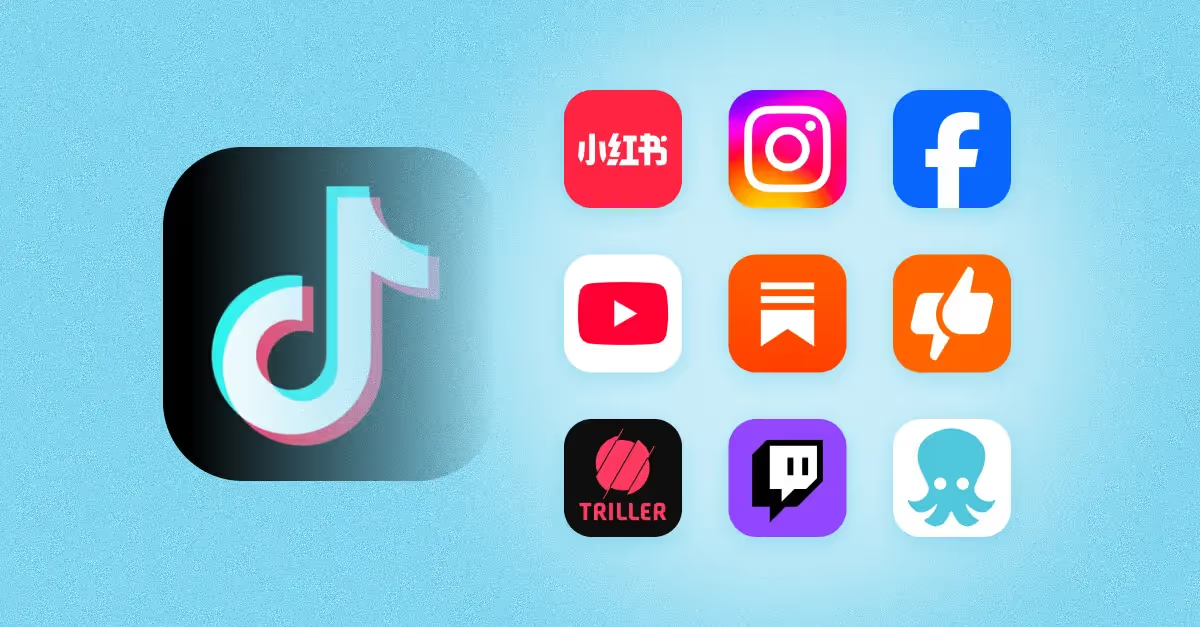Best Time To Post on TikTok in 2025 (289K Posts Analyzed)
Data-backed insights to find the best times to post on TikTok by day, hour and industry.
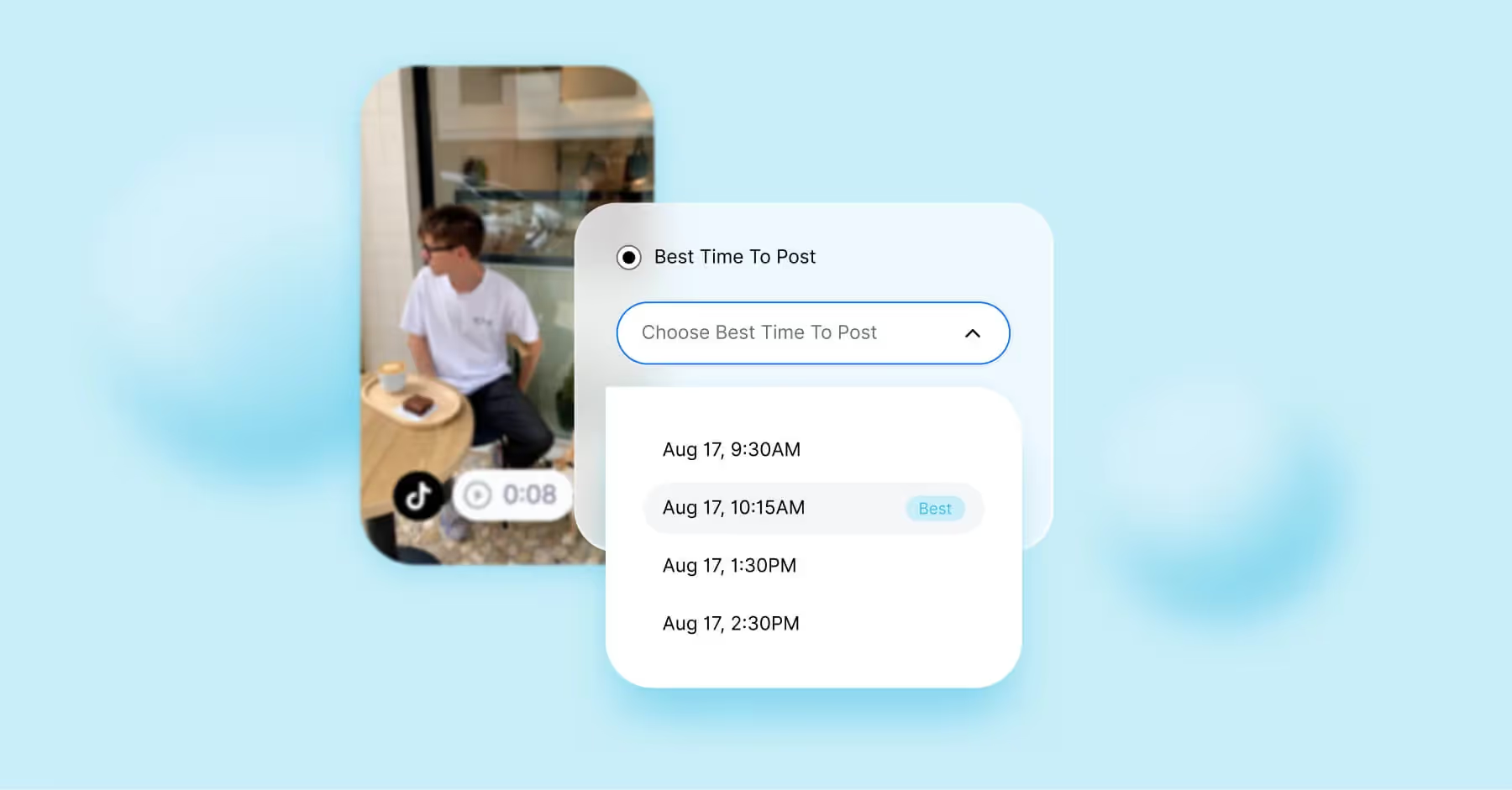
Contents
When Is the Best Time To Post on TikTok for Brands in 2025Best Days and Times To Post on TikTokBest Time To Post on TikTok in the UKBest Time To Post on TikTok in AustraliaThe Best Times To Post on TikTok, Broken Down by IndustryFactors That Influence the Best Time To Post on TikTokHow To Find Your Best Time To Post on TikTok Using TikTok InsightsWhy a Tool Is Better Than Native TikTok Analytics for Finding the Best Time To PostBest Time To Post on TikTok FAQsKnowing what to post on TikTok is only half the equation; when exactly you post can make or break your content’s performance. With TikTok’s algorithm constantly learning and growing, and audience behavior shifting around the clock, brands need more than guesswork to stand out. That’s why we analyzed over 289,000 TikTok posts from brands around the globe to uncover the real posting patterns behind high engagement.
TL;DR:
- The best global times to post on TikTok are Monday between 1-2 a.m. and 11 p.m. to midnight, Tuesday from 2-3 a.m., Friday between 9-10 p.m., Saturday 11 p.m. to midnight and Sunday from 4-5 a.m. and from 10 p.m. to midnight (local time).
- Late-night and early-morning posts consistently outperform daytime slots in engagement.
- Sunday is the top-performing day for views and engagement.
- Posting 3–5 times per week is ideal. Quality over quantity still matters.
- Avoid mid-afternoon weekday posts (2–6 p.m.) when engagement tends to dip.
- Beauty and media industry brands see peak engagement late at night. In comparison, fashion, retail, and publishing perform best in the early morning hours.
When Is the Best Time To Post on TikTok for Brands in 2025
Timing is everything on TikTok, just ask florence by mills. The Gen Z beauty brand founded by Millie Bobby Brown used TikTok Insights to better understand when and how their audience engages with their content. The result? A +797% increase in video views and a +273% higher engagement rate than the beauty industry average. While creative execution plays a role, performance like that just doesn’t happen without strategy, including knowing the best time to post content.
In this article, we break down the best times to post on TikTok based on an analysis of over 289,000 brand videos shared throughout 2024, helping you optimize for visibility, engagement, and growth.
NOTE: The data featured in this article was collected and analyzed by Dash Social’s Senior Data Analyst. Our analysis includes performance insights from 289,079 unique TikTok posts published globally by more than 1,000 brands through the Dash Social platform. The dataset spans from January 1 to December 31, 2024, offering a comprehensive look at brand engagement performance across the full calendar year. The suggested best time represents a one-hour time frame, meaning any content posted within that 60-minute range contributed to the engagement data.
Best Days and Times To Post on TikTok
When it comes to TikTok, timing really does matter, and while there’s no one-size-fits-all posting window, the data reveals clear trends. If your goal is to maximize visibility and engagement, these local time slots consistently deliver average engagement rates of 5.7% or higher:
- Monday between 11 p.m. to 12 a.m. and 1 a.m. to 2 a.m. (5.8% engagement rate)
- Tuesday between 12 a.m. and 1 a.m. (5.7% and 5.8% engagement rate, respectively)
- Friday between 9 p.m. to 10 p.m. (5.7% engagement rate)
- Saturday between 11 p.m. - 12 a.m. (5.7% engagement rate)
- Sunday between 10 p.m. to 12 a.m. (5.8% engagement rate) and 4 a.m. to 5 a.m. (5.9% engagement rate)
Late-night and early-morning hours appear to be peak windows when competition is lower and users are more likely to engage with content that surfaces in their feed.
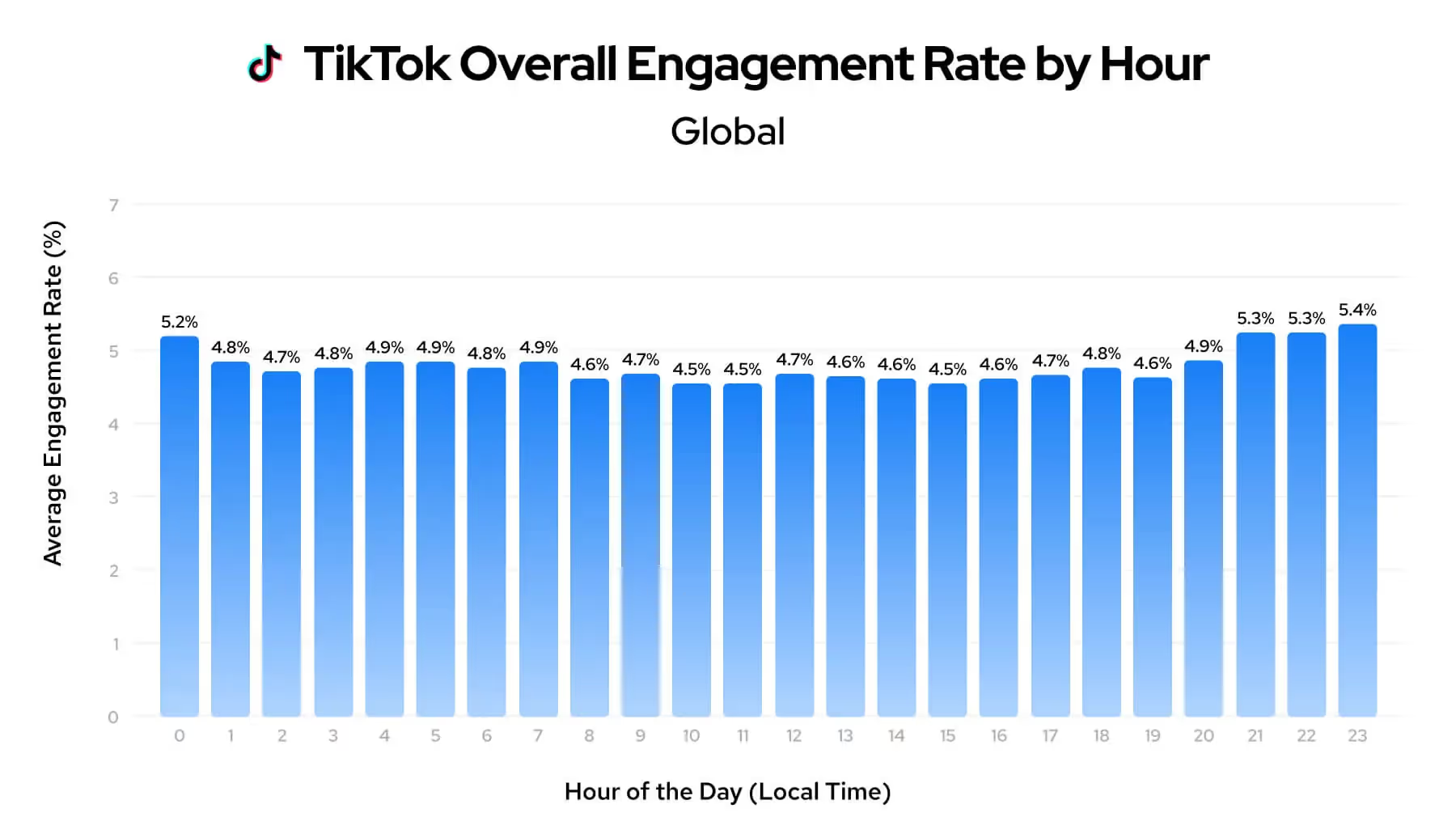
The Best Time To Post on TikTok on Monday
Engagement peaks from 11 p.m. to 12 a.m. and 1 a.m. to 2 a.m., with strong rates continuing in between. This pattern suggests users are active late Sunday night into early Monday, possibly browsing in bed or unwinding before the work week. After 4 a.m., engagement dips and remains lower during traditional work hours before picking back up at around 9-10 p.m.
The Best Time To Post on TikTok on Tuesday
The best time to post on TikTok on a Tuesday is between 12 a.m. to 1 a.m., and 2 a.m. to 3 a.m. This early-morning spike likely reflects continued late-night scrolling from Monday, especially for users whose weekends fall on Sunday and Monday, such as those in hospitality or retail. Or people who refuse to admit the week of work or school has started. Whatever the reason, after this window, engagement remains low and doesn’t pick up meaningfully again until Friday evening, making Tuesday’s early hours a valuable opportunity for visibility and staying top of mind for the rest of the week.
The Best Time To Post on TikTok on Wednesday
If you're posting to TikTok on a Wednesday, aim for the 12 a.m. to 1 a.m. window; it’s the peak engagement time for the day, though slightly lower than Monday and Tuesday. Engagement gradually decreases after 2 a.m. and stays moderate through the afternoon, suggesting that midweek busyness and fatigue begin to affect user behavior.
The Best Time To Post on TikTok on Thursday
Thursday sees some of the lowest engagement rates of the week, including the weakest peak performance compared to other days. It's a good day for testing content if you're experimenting with consistency or multi-post strategies. Engagement begins to rise again late in the evening (around 9 p.m. – 11 p.m.), but not as sharply as on other days.
The Best Time To Post on TikTok on Friday
Things tend to pick back up on Friday evening, with engagement peaking between 9 p.m. to 10 p.m. Unlike other late-night trends, though, activity doesn’t continue climbing. Many users either have Friday night plans or are simply too worn out from the week to stay up late and scroll.
The Best Time To Post on TikTok on Saturday
The best time to post on TikTok on a Saturday is between 11 p.m. and 12 a.m., but if we can tiptoe into Sunday territory, things get even more interesting. Engagement starts climbing again around 3 a.m. and stays relatively high through to 6 a.m., with the hour between 4 a.m. to 5 a.m. clocking in with the highest engagement rate of the entire week at 5.9%. This mix of early and late engagement windows suggests two key behaviors: late Saturday night scrollers and Sunday night wind-down users. Brands can take advantage of both by posting in these time slots. And with less competition and global TikTok algorithm reach, strong content at these hours has a better chance of standing out and getting picked up.
The Best Time To Post on TikTok on Sunday
For posting on TikTok on Sunday, aim for the 10 p.m. to 12 a.m. window. It offers the longest stretch of high engagement during the week. As mentioned earlier, posting between 4 a.m. to 5 a.m. also sees the highest single engagement rate of the entire week. This mix of early-morning and late-night activity points to two distinct user behaviors: late Saturday night scrollers and Sunday night wind-down users.
Brands can take advantage of both by scheduling content around these peak windows:
Best Time To Post on TikTok in the UK
While the analysis above is based on global data, we segmented out over 33,000 posts from 137 UK brands to identify, on average, the best time to post on TikTok in the UK. Here’s what we found:
- The top-performing window is between 5 a.m. to 6 a.m., with an average engagement rate of 5.9%. This is the highest across any hour of the day or week.
- A secondary peak appears earlier, between 2 a.m. and 3 a.m. (5.6%) and 3 a.m. and 4 a.m. (5.3%).
From 8 a.m. through 5 p.m., engagement levels flatten out to an average of 4.4%, suggesting that midday is not the best time to post unless you’re experimenting or targeting niche segments. During this time span, we see increased competition from brands posting and lower user activity, which may mean audiences are less engaged or simply not on the platform.
This imbalance between high content volume and low user interaction suggests that midday is not ideal for brands chasing performance metrics unless you're targeting a certain niche or testing content consistency.
To make the most of this insight, brands should consider:
- Scheduling posts between 2 a.m. – 4 a.m. or between 5 a.m. - 6 p.m. for optimal visibility.
- Testing 5 p.m. - 6 p.m. as a potential evening alternative for catching after-work and after-school users.
- Using scheduled posting tools to hit these off-peak hours without needing to manually post overnight.
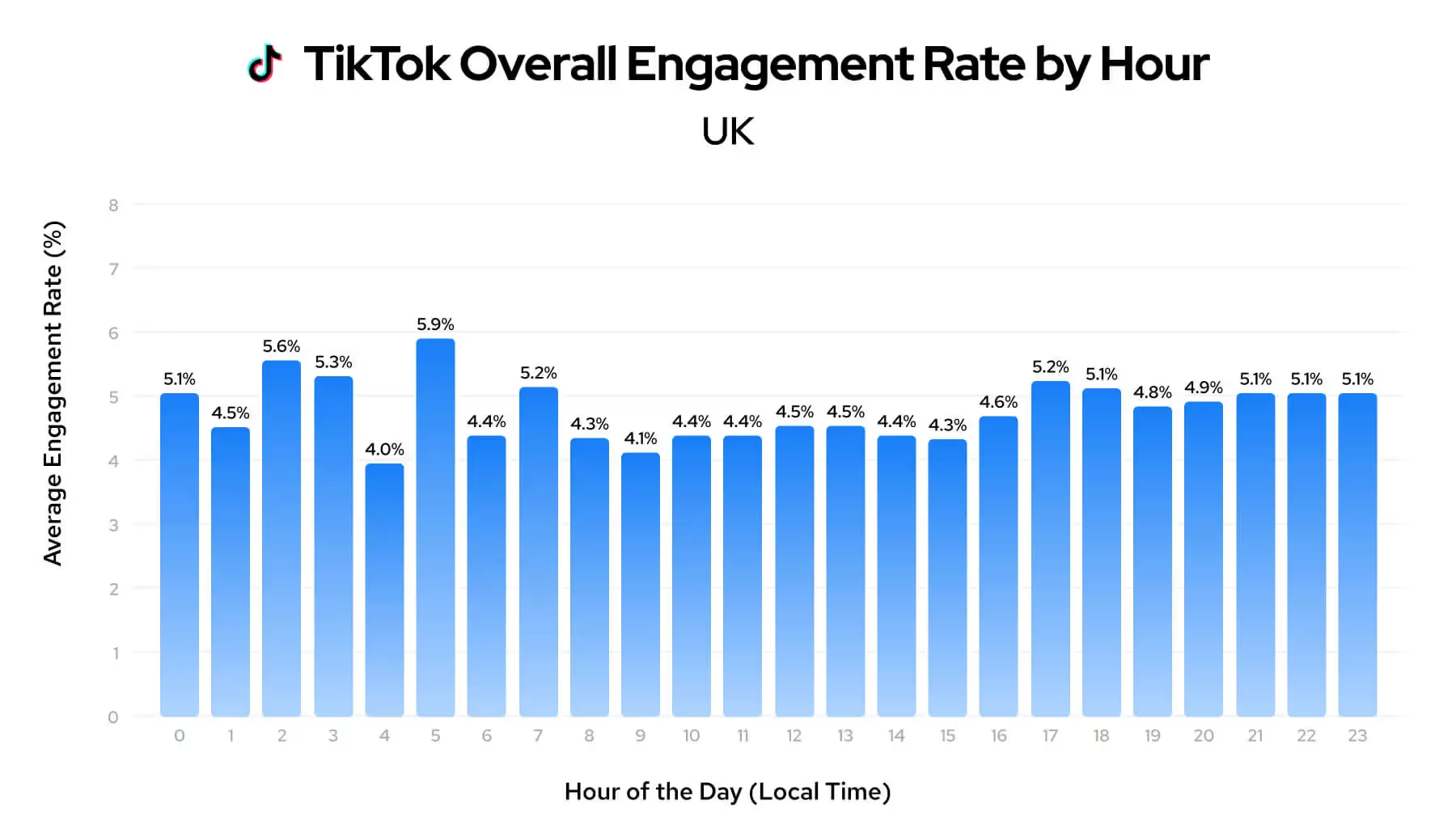
Best Time To Post on TikTok in Australia
Next, we wanted to find out what the average best time to post on TikTok in Australia is to see if we spot any differences. To do this, we segmented out 15,127 posts from 55 Australian brands to identify, on average, the best times to post. Here’s what we found:
- The top-performing hour is between 11 p.m. and midnight, with an average engagement rate of 5.1%. This is the highest across any hour of the day.
- A secondary peak occurs in the early morning, between midnight and 1 a.m. (5.0%) and 3 a.m. to 4 a.m. (4.9%).
From 9 a.m. through to 6 p.m., engagement rates drop and stay consistently low, averaging between 3.2% and 3.5%. This suggests brand performance on TikTok in Australia doesn’t differ much compared to the UK or from our global data.
To make the most of this insight, brands should consider:
- Scheduling posts between 11 p.m. to 12 a.m. and 3 a.m. to 4 a.m., where engagement levels are highest.
- Avoid the 9 a.m. – 6 p.m. window unless running specific tests or niche campaigns.
- Using scheduled posting tools to consistently reach late-night audiences without needing to post manually.
The Best Times To Post on TikTok, Broken Down by Industry
The best time to post on TikTok isn’t universal; it varies by industry. Different audiences have distinct engagement patterns shaped by their daily routines, the type of content they consume and their intent when using the platform. Below, we break down the top-performing time slots for each industry based on real engagement data. So you can benchmark your performance against top-performing industry averages and reach your audience when they’re most likely to care.
Best Time To Post on TikTok for the Beauty Industry
- From 75,956 unique posts analyzed, the average best time to post on TikTok for beauty brands is between 10 p.m. and 11 p.m.
- Audiences are highly engaged with skincare and makeup tutorials during their wind-down hours.
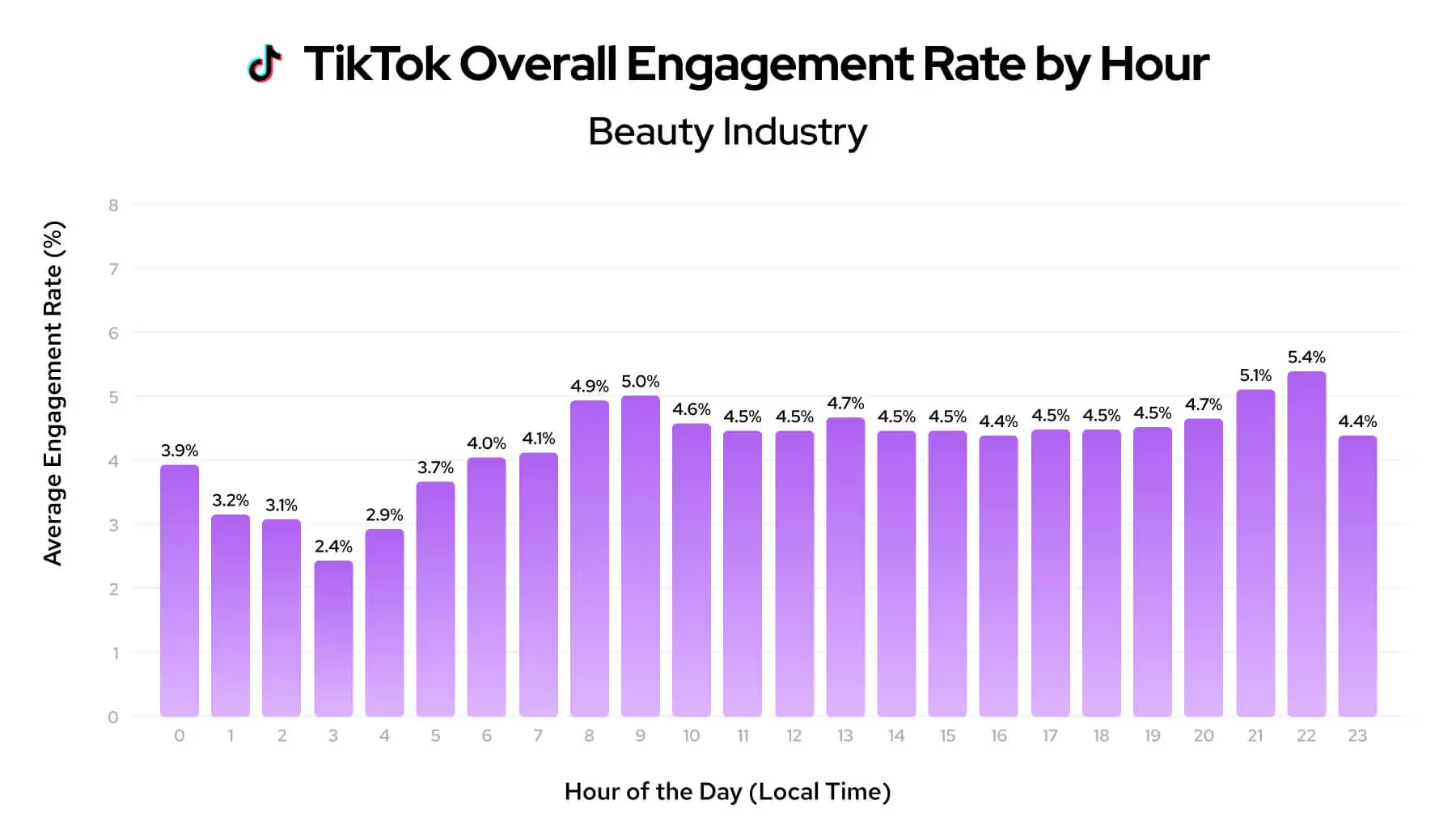
Best Time To Post on TikTok for the Fashion Industry
- From 49,763 unique posts analyzed, the average best time to post on TikTok for fashion industry brands is between 6 a.m. to 7 a.m.
For fashion brands, this window is prime real estate to insert themselves into ‘get ready with me’ (GRWM) culture or style inspo feeds as people get ready for their day.

Best Time To Post on TikTok for the Media Industry
- From 50,390 unique posts analyzed, the average best time to post on TikTok for brands in the media industry is between 11 p.m. and 12 a.m.
- Media content thrives at night because it aligns with how people consume news, culture and entertainment: casually, passively and in bed.

Best Time To Post on TikTok for the Publishing Industry
- From 69,162 unique posts analyzed, the average best time to post on TikTok for brands in the publishing industry is between 1 a.m. and 2 p.m. and 3 a.m. and 4 a.m.
- Posting late at night or just before midnight gives content maximum time to build engagement overnight, often boosting visibility by morning. BookTok content performs especially well during quiet moments.
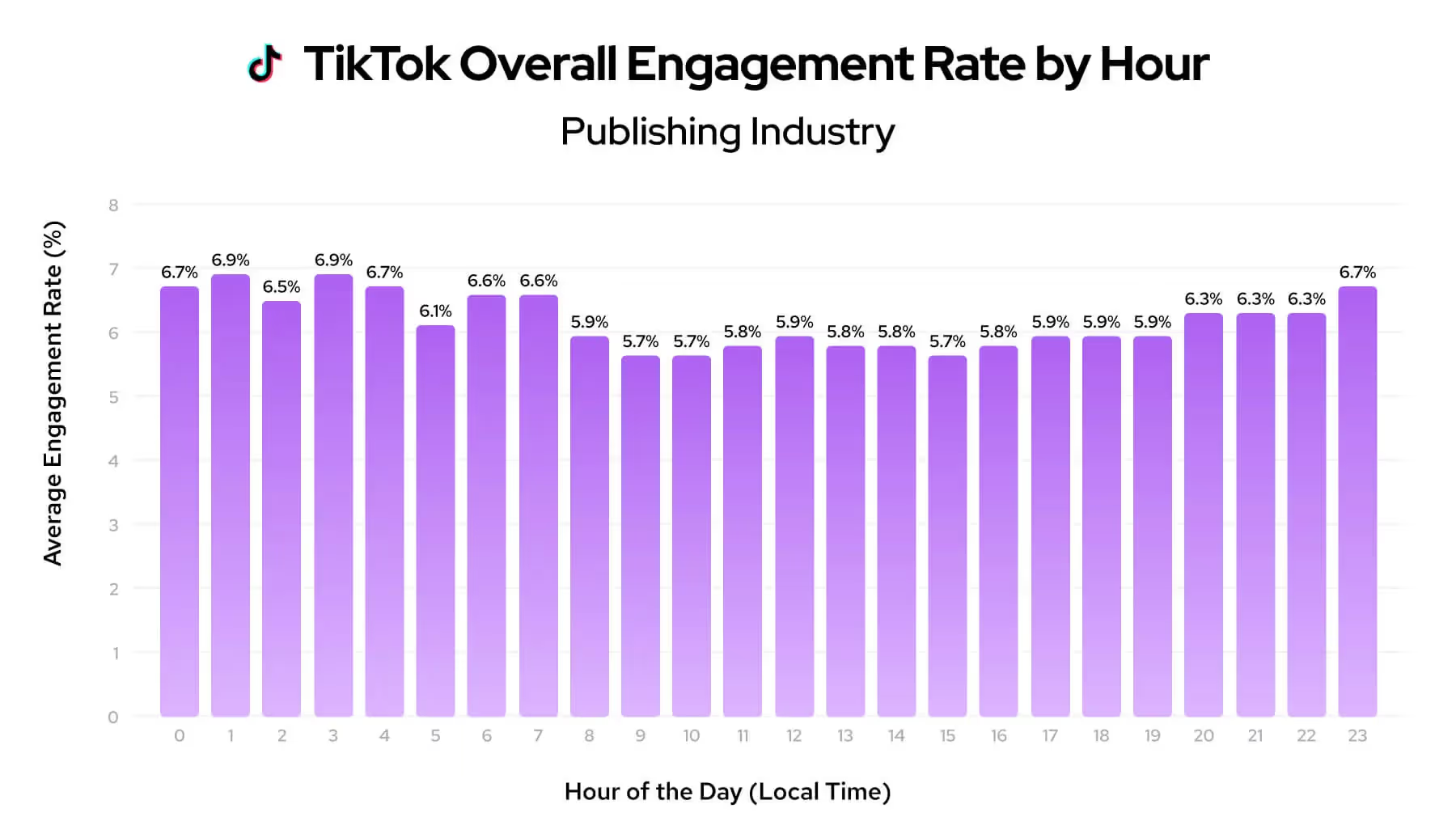
Best Time To Post on TikTok for the Retail Industry
- From 32,962 unique posts analyzed, the average best time to post on TikTok for retail brands is between 6 a.m. to 7 a.m.
- TikTok engagement in the retail sector is relatively steady, with fewer extreme highs and lows than in other industries.
- Shopping content tends to align with daytime routines, likely shaped by work schedules, purchase intent and brand-led posting strategies.

Factors That Influence the Best Time To Post on TikTok
Maybe your brand’s best time to post doesn’t line up with the trends we’ve outlined above, and that’s okay. As we’ve mentioned, there’s no universal ‘perfect time’ to post on TikTok. Audience behavior varies depending on a range of shifting factors. Understanding what influences these patterns can help brands find the best posting window for their specific goals and audiences.
1. Audience Demographics
Your followers’ age, lifestyle and location heavily influence when they’re online:
- Gen Z users are most active late at night and early morning.
- Working professionals tend to engage during breaks or after work hours.
- Global audiences introduce time zone considerations. What’s 9 a.m. for you may be midnight for them.
2. Day of the Week
Weekday vs. weekend behavior can vary drastically:
- Weekdays often have predictable scroll patterns (e.g., morning commute, lunch breaks, evening wind-down).
- Weekends introduce more late-night activity and early morning engagement spikes, especially on Sunday.
3. Content Type
Not all content performs the same at all times:
- Entertainment and storytelling content tend to do better at night when users have more time.
- Educational or product-focused content may perform better during the day when attention spans are sharper.
4. TikTok’s Algorithm
TikTok doesn’t serve content purely based on when it was posted, but early engagement still matters:
- Posting during high-activity windows can help boost watch time, likes and shares early on, which increases your chances of being promoted by the algorithm.
- Momentum is everything. Strong engagement in the first hour can make or break a video’s reach.
5. Posting Consistency
Your own posting habits also influence performance:
- If your audience is used to seeing your content at a certain time, they may be more likely to engage consistently.
- Sporadic or unpredictable posting can confuse the algorithm and your followers.
It really comes down to who you're trying to reach, what you're posting and when your audience is most likely to be active. The key is to experiment, track performance and adjust based on what resonates with your audience and how the algorithm responds.
How To Find Your Best Time To Post on TikTok Using TikTok Insights
While industry benchmarks are helpful, the best way to find your brand’s ideal posting time is through TikTok’s built-in analytics, or even better, a scheduling tool that gives you recommended best times to post when you schedule your content. Here's a step-by-step guide to help you unlock that data and turn it into an optimized posting schedule.
Step 1: Switch to a TikTok Business or Creator Account
To access TikTok analytics, you’ll need to be using either a Business or Creator account. Here's how to switch:
- Go to your profile
- Tap the three lines in the top-right corner
- Navigate to Settings and Privacy > Account > Switch to Business Account (or Creator)
- Choose the category that best fits your brand and follow the prompts
Once switched, you’ll gain access to TikTok’s Analytics dashboard:
- Go back to your profile, tap the three lines, then go to Creator Tools > Analytics
- You’ll land on the ‘Overview’ tab, which provides topline performance metrics
Step 2: Check Follower Activity
This is the most valuable feature for determining when your audience is online:
- Go to the ‘Followers’ tab
- Scroll down to ‘Follower Activity’
- Review which days and hours your followers are most active
Note: TikTok displays this data in UTC (Coordinated Universal Time), so be sure to convert it to your local time zone.
This gives you a solid foundation for choosing when to post based on your actual audience behavior.
Step 3: Review Top-Performing Content
Now head to the Content tab and dig into what’s already working:
- Identify posts with high engagement (likes, shares, comments, watch time)
- Take note of when they were posted, including time of day and day of week
- Look for patterns across your top-performing videos
Combining this with your follower activity gives you context not just around when your audience is active, but when they’re actually engaging.
Step 4: Test and Refine
With those insights in hand, start building your content schedule:
- Post during peak windows identified in Steps 2 and 3
- Try A/B testing different time slots over the course of a few weeks
- Regularly return to your ‘Follower Activity’ and ‘Content’ tabs to monitor performance shifts
TikTok’s audience behavior is dynamic, so don’t set your posting times in stone. Treat them as a fluid strategy you can tweak over time.
Why a Tool Is Better Than Native TikTok Analytics for Finding the Best Time To Post
While TikTok's built-in analytics offer helpful follower activity data, they’re limited to your own audience and surface-level trends. A third-party tool like Dash Social gives you a broader, data-backed view of what’s actually working across your industry, competitors and high-performing content globally.
Here’s why tools outperform native analytics:
- Time Zone Normalization: TikTok presents follower data in UTC without converting for local time zones. Tools automatically localize insights, so you don’t have to do the math.
- Broader Dataset: Tools aggregate performance data from hundreds or thousands of brands, not just yours, giving you statistically significant insights into what’s working across categories and audiences.
- Actual Engagement, Not Just Activity: TikTok shows when your followers are online, but that doesn’t mean they’re engaging. Tools reveal when engagement (likes, comments, shares) actually peaks based on real outcomes, not just presence.
- Benchmarking: Tools let you compare your performance against competitors and industry standards, helping you understand whether your content is thriving or underperforming.
- Post Scheduling Integration: Tools often include smart scheduling features that recommend optimal posting times based on both platform-wide and brand-specific performance. No guesswork required.
- Historical Trends: Native analytics are limited in scope and history. Tools often store months (or years) of data for long-term trend analysis.
Best Time To Post on TikTok FAQs
How often should you post on TikTok?
Aim to post 3–5 times per week to stay consistent and build momentum. TikTok recommends up to 1–4 posts per day, but quality matters more than quantity. Focus on creating engaging, valuable content that your audience actually wants to watch.
What day gets the most views on TikTok?
Sunday consistently drives the highest views and engagement across all industries. Late-night and early-morning posts on Sundays (especially between 4–5 a.m. and 10 p.m.–12 a.m.) perform best, likely due to lower competition and users winding down before the week starts.
Is posting too much on TikTok bad?
Not really. Unlike other platforms, TikTok’s algorithm doesn’t penalize frequent posting. In fact, posting multiple times a day can increase your chances of reaching different audience segments, as long as the content is high quality. Focus on consistency and value, not just volume.
Should I post every day on TikTok?
You can, but you don’t have to. Posting daily can help grow your audience faster, especially if you're testing content and learning what works. But 3–5 high-quality posts per week are enough to stay consistent and keep engagement strong without burning out.
What is the worst time to post on TikTok?
The worst time to post is typically weekdays between 2 and 6 p.m. During this window, engagement rates drop as users are busy with work, school or other daytime routines. Content posted during these hours often gets buried before peak activity resumes later in the evening.





